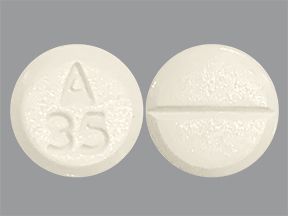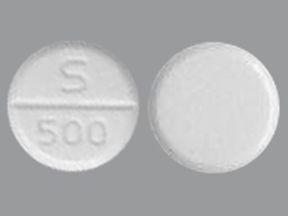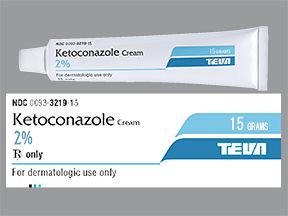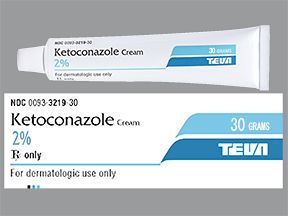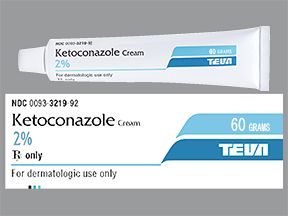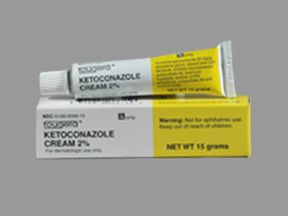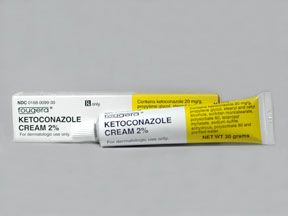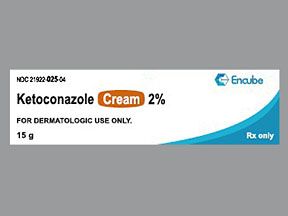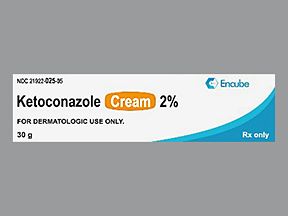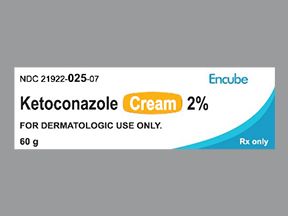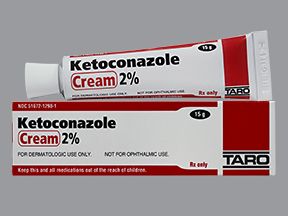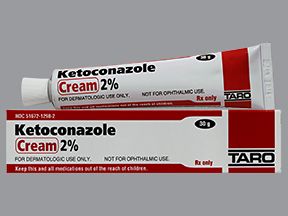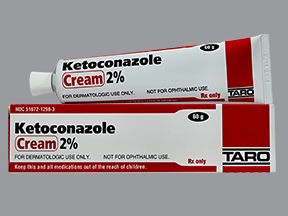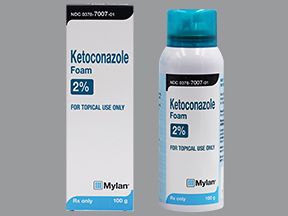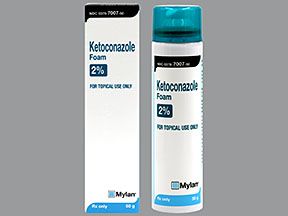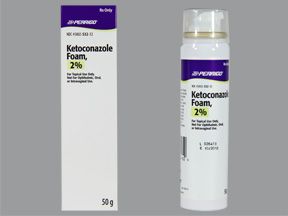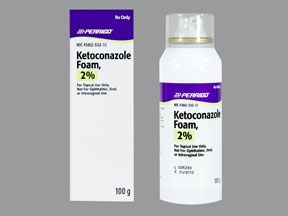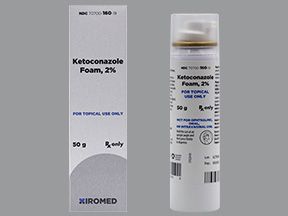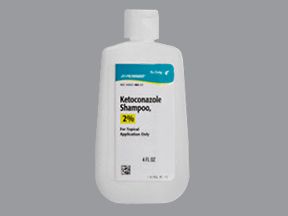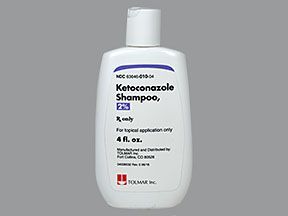This drug has boxed warnings. A boxed warning is the most serious warning from the Food and Drug Administration (FDA). It alerts doctors and patients about drug effects that may be dangerous.
- Liver failure: This drug can cause liver failure. Your doctor will monitor your liver function while you’re on this medication.
- Not for use as a first treatment: This drug should only be used when other treatments aren’t an option or when the possible benefits of this drug outweigh the risks. These serious risks include liver failure and heart rhythm problems.
- QT prolongation and drug interactions leading to QT prolongation: Taking ketoconazole with certain drugs can cause changes in the electrical activity of your heart called QT prolongation. QT prolongation can cause irregular heartbeats that can be life threatening. These medications include dofetilide, quinidine, pimozide, cisapride, methadone, disopyramide, dronedarone, ranolazine and should not be used with ketoconazole , due to increased risk of life threatening heart rate or heart rhythm problems.
- Appropriate use: Because ketoconazole tablets can cause serious side effects, ketoconazole tablets should not be used for the treatment of onychomycosis, cutaneous dermatophyte infections, or Candida infections. Use ketoconazole only when other effective antifungal therapy is not available or tolerated and the potential benefits are considered to outweigh the potential risks.
- Liver problems (hepatotoxicity): Liver failure, requiring liver transplantation has occurred with the use of oral ketoconazole. Taking this drug increases your risk of liver damage and your doctor must closely monitor your liver function.
- Ketoconazole oral tablet is only available as a generic drug.
- Ketoconazole is used to treat fungal and yeast infections on your skin, hair, nails, and in your blood.
- This drug is available as an oral tablet, topical cream, shampoo, and topical gel.
Ketoconazole is a prescription drug. It’s available as an oral tablet, topical cream, topical foam, shampoo, and topical gel. The oral tablet is only available as a generic drug.
Why it’s used
Ketoconazole is used to treat fungal and yeast infections on your skin, hair, nails, and in your blood. This drug is only given when other treatments haven’t worked or caused too many side effects.
How it works
Ketoconazole belongs to a class of drugs called antifungals. A class of drugs is a group of medications that work in a similar way. These drugs are often used to treat similar conditions.
Ketoconazole works to stop fungi and yeasts from causing an infection.
Ketoconazole can cause mild or serious side effects. The following list contains some of the key side effects that may occur while taking ketoconazole.
This list does not include all possible side effects.
For more information on the possible side effects of ketoconazole, or tips on how to deal with a troubling side effect, talk with your doctor or pharmacist.
More common side effects
Some of the more common side effects of ketoconazole include:
- nausea
- headache
- diarrhea
- stomach pain
- abnormal liver function test results
If these effects are mild, they may go away within a few days or a couple of weeks. If they’re more severe or don’t go away, talk to your doctor or pharmacist.
Serious side effects
Call your doctor right away if you have serious side effects. Call 911 if your symptoms feel life threatening or if you think you’re having a medical emergency. Serious side effects and their symptoms can include the following:
- Liver problems (hepatotoxicity). Symptoms can include:
- loss of appetite or weight loss (anorexia)
- nausea or vomiting
- tiredness
- stomach pain or tenderness
- dark-colored urine or light-colored stools
- yellowing of your skin or the whites of your eyes
- fever
- rash
Ketoconazole interactions can cause changes in the electrical activity of your heart called QT prolongation. QT prolongation can cause irregular heartbeats that can be life threatening.
This can happen if you use ketoconazole tablets with certain medications, such as dofetilide, quinidine, pimozide, cisapride, methadone, disopyramide, dronedarone, and ranolazine.
Talk to your healthcare provider about other medications you’re taking before you start taking ketoconazole tablets.
Tell your healthcare provider right away if you feel faint, lightheaded, dizzy, or feel your heart beating irregularly or fast. These may be symptoms related to QT prolongation.
The ketoconazole dosage your doctor prescribes will depend on several factors. These include:
- the type and severity of the condition you’re using ketoconazole to treat
- your age
- the form of ketoconazole you take
- other medical conditions you may have
Typically, your doctor will start you on a low dosage and adjust it over time to reach the dosage that’s right for you. They’ll ultimately prescribe the smallest dosage that provides the desired effect.
The following information describes dosages that are commonly used or recommended. However, be sure to take the dosage your doctor prescribes for you. Your doctor will determine the best dosage to suit your needs.
Form and strength
Generic: Ketoconazole
- Form: oral tablet
- Strength: 200 mg
Dosage for fungal infections
Adult dosage (ages 18 years and older)
- Typical dosage: 200 mg taken once per day for up to 6 months.
- Dosage increases: Your doctor may increase your dosage to 400 mg taken once per day if needed.
Child dosage (ages 2–17 years)
Your doctor will decide a dosage based on your child’s weight. The dosage will range from 3.3–6.6 mg/kg of body weight taken once per day.
Child dosage (ages 0–1 years)
It hasn’t been confirmed that ketoconazole is safe and effective for use in people younger than 2 years. In general, ketoconazole tablets shouldn’t be used in young children.
Ketoconazole is used for short-term treatment. However, sometimes it needs to be taken for several months. Ketoconazole comes with risks if you don’t take it as prescribed.
If you stop taking the drug or don’t take it at all
Your infection or skin condition won’t get better.
If you miss doses or don’t take the drug on schedule
Your medication may not work as well or may stop working completely. For this drug to work well, a certain amount needs to be in your body at all times.
If you take too much
You could have dangerous levels of the drug in your body. Symptoms of an overdose of this drug can include:
- nausea
- vomiting
- diarrhea
If you think you’ve taken too much of this drug, call your doctor or local poison control center. If your symptoms are severe, call 911 or go to the nearest emergency room right away.
What to do if you miss a dose
Take your dose as soon as you remember. But if you remember just a few hours before your next scheduled dose, take only one dose. Never try to catch up by taking two doses at once. This could result in dangerous side effects.
How to tell if the drug is working
Your skin condition or infection should improve.
This drug comes with several warnings.
FDA warnings
- This drug has black box warnings. These are the most serious warnings from the Food and Drug Administration (FDA). A black box warning alerts doctors and patients about drug effects that may be dangerous.
- Liver failure. This drug can cause liver failure. Your doctor will monitor your liver function while you’re on this medication.
- Not for use as a first treatment. This drug should only be used when other treatments aren’t an option or when the possible benefits of this drug outweigh the risks. These serious risks include liver failure and heart rhythm problems.
- QT prolongation and drug interactions leading to QT prolongation: Taking ketoconazole with certain drugs can cause changes in the electrical activity of your heart called QT prolongation. QT prolongation can cause irregular heartbeats that can be life threatening. These medications include dofetilide, quinidine, pimozide, cisapride, methadone, disopyramide, dronedarone, ranolazine and should not be used with ketoconazole, due to an increased risk of life threatening heart rate or heart rhythm problems.
- Appropriate use: Because ketoconazole tablets can cause serious side effects, ketoconazole tablets should not be used for the treatment of onychomycosis, cutaneous dermatophyte infections, or Candida infections. Use ketoconazole only when other effective antifungal therapy is not available or tolerated and the potential benefits are considered to outweigh the potential risks.
- Liver problems (hepatotoxicity): Liver failure, requiring liver transplantation has occurred with the use of oral ketoconazole. Taking this drug increases your risk for liver damage, and your doctor must closely monitor your liver function.
Hormone problem warnings
High doses of this drug can affect your body’s ability to secrete hormones in response to stress.
Symptoms can include extreme thirst, weight loss, darkening of your skin, unusual tiredness, joint aches and pains, and loss of appetite. If you have these symptoms, call your doctor.
Allergies
Ketoconazole tablets can cause a severe allergic reaction. Symptoms can include:
- shortness of breath
- coughing
- wheezing
- fever
- chills
- throbbing of your heart or ears
- swelling of your eyelids, face, mouth, neck, or any other part of your body
- skin rash, hives, blisters, or peeling of your skin
If you have an allergic reaction, call your doctor or local poison control center right away. If your symptoms are severe, call 911 or go to the nearest emergency room.
Don’t take this drug again if you’ve ever had an allergic reaction to it. Taking it again could be fatal (cause death).
Alcohol interaction
You shouldn’t drink alcohol while taking ketoconazole. Drinking alcohol can increase your risk for liver damage while taking this drug. If you drink alcohol, talk to your doctor.
Warnings for certain groups
For pregnant women: Ketoconazole is a category C pregnancy drug. That means two things:
- Research in animals has shown negative effects to the fetus when the mother takes the drug.
- There haven’t been enough studies done in humans to be certain how the drug might affect the fetus.
Talk to your doctor if you’re pregnant or planning to become pregnant. This drug should be used only if the potential benefit justifies the potential risk to the fetus.
For women who are breastfeeding: Ketoconazole passes into breast milk and may cause side effects in a child who’s breastfed. Talk to your doctor if you breastfeed your child. Ketoconazole has been shown to be excreted in the milk. Breastfeeding isn’t recommended by the manufacturer.
For children: It hasn’t been confirmed that ketoconazole is safe and effective for use in people younger than 2 years. In general, ketoconazole tablets shouldn’t be used in children.
Ketoconazole can interact with several other medications. Different interactions can cause different effects. For instance, some can interfere with how well a drug works, while others can cause increased side effects.
Below is a list of medications that can interact with ketoconazole. This list does not contain all drugs that may interact with ketoconazole.
Before taking ketoconazole, be sure to tell your doctor and pharmacist about all prescription, over-the-counter, and other drugs you take. Also tell them about any vitamins, herbs, and supplements you use. Sharing this information can help you avoid potential interactions.
If you have questions about drug interactions that may affect you, ask your doctor or pharmacist.
Drugs you should not use with ketoconazole
Certain drugs should not be taken with ketoconazole. Doing so can cause dangerous effects in the body. Examples of these drugs include:
- Antiarrhythmic drugs, such as dofetilide, quinidine, and dronedarone. Taking these drugs with ketoconazole may cause a heart problem called QT prolongation. This is a change in the electrical activity in the heart. It can cause irregular heartbeats and be life threatening.
- Methadone. Taking these drugs together may cause a heart problem called QT prolongation. This is a change in the electrical activity in the heart. It can cause irregular heartbeats and be life threatening.
- Ranolazine. Taking these drugs together may cause a heart problem called QT prolongation. This is a change in the electrical activity in the heart. It can cause irregular heartbeats and be life threatening.
- Simvastatin or lovastatin. Taking ketoconazole with these drugs may cause muscle problems.
- Triazolam, midazolam, or alprazolam. Taking these drugs together may make you feel very drowsy for a long period of time.
- Eplerenone. Taking these drugs together may cause low blood pressure and low potassium levels.
- Dofetilide, quinidine, pimozide, cisapride, methadone, disopyramide, dronedarone, and ranolazine: Taking ketoconazole with these drugs can cause changes in the electrical activity of your heart called QT prolongation. QT prolongation can cause irregular heartbeats that can be life threatening.
Interactions that increase your risk of side effects
Taking certain drugs with ketoconazole raises your risk of side effects.
- Side effects from ketoconazole: Taking ketoconazole with certain medications raises your risk for side effects from ketoconazole. This is because the amount of ketoconazole in your body is increased. Examples of these drugs include:
- ritonavir
- atorvastatin
- Side effects from other drugs: Taking ketoconazole with certain medications raises your risk for side effects from these drugs. Examples of these drugs include:
- Pain drugs, such as buprenorphine, fentanyl, and oxycodone. Taking these drugs with ketoconazole may cause slowed breathing.
- Anticoagulants, such as rivaroxaban, dabigatran, and warfarin. Taking these drugs with ketoconazole may increase your risk for bleeding.
- Heart drugs, such as felodipine and nisoldipine. Taking these drugs with ketoconazole may cause swelling of your legs or arms and heart failure.
- Tamsulosin. Taking these drugs together may cause headache, dizziness, and orthostatic hypotension (low blood pressure when you stand up from a sitting or lying position).
- Digoxin. Taking these drugs together may cause dizziness, headache, and stomach pain. Your doctor may monitor your digoxin blood levels.
- Eletriptan. Taking these drugs together may cause weakness, nausea, dizziness, and drowsiness.
- Antipsychotic drugs, such as aripiprazole, buspirone, haloperidol, quetiapine, and risperidone. Taking these drugs with ketoconazole may cause dizziness, drowsiness, and headaches.
- Ramelteon. Taking these drugs together may cause dizziness, drowsiness, and fatigue.
- Antivirals such as indinavir, maraviroc, and saquinavir. Taking these drugs with ketoconazole may cause stomach pain, nausea, and headaches.
- Blood pressure drugs, such as verapamil and aliskiren. Taking these drugs with ketoconazole may cause low blood pressure, low heart rate, and dizziness.
- Drugs for erectile dysfunction, such as sildenafil, tadalafil, and vardenafil. Taking these drugs with ketoconazole may cause headaches, upset stomach, and muscle pain.
- Drugs for urine problems, such as solifenacin and tolterodine. Taking these drugs with ketoconazole may cause dry mouth, headaches, and dizziness.
Interactions that can make your drugs less effective
- When ketoconazole is less effective: When ketoconazole is used with certain drugs, it may not work as well to treat your condition. This is because the amount of ketoconazole in your body may be decreased. Examples of these drugs include:
- Famotidine, cimetidine, pantoprazole, omeprazole, and rabeprazole. You should take ketoconazole with an acidic beverage, such as a non-diet soda, if you take these drugs together.
- Aluminum hydroxide. You should take this drug 1 hour before or 2 hours after taking ketoconazole.
- Antibiotics, such as isoniazid and rifabutin
- Anticonvulsants, such as carbamazepine and phenytoin
- Antivirals, such as efavirenz and nevirapine
- Carbamazepine. Your doctor may monitor your carbamazepine levels.
Keep these considerations in mind if your doctor prescribes ketoconazole for you.
General
You should take ketoconazole tablets with a meal.
Storage
- Store this drug at a temperature between 68°F and 77°F (20°C and 25°C).
- Protect this drug from light.
- Don’t store this medication in moist or damp areas, such as bathrooms.
Refills
A prescription for this medication is refillable. You should not need a new prescription for this medication to be refilled. Your doctor will write the number of refills authorized on your prescription.
Travel
When traveling with your medication:
- Always carry your medication with you. When flying, never put it into a checked bag. Keep it in your carry-on bag.
- Don’t worry about airport X-ray machines. They can’t hurt your medication.
- You may need to show airport staff the pharmacy label for your medication. Always carry the original prescription-labeled box with you.
- Don’t put this medication in your car’s glove compartment or leave it in the car. Be sure to avoid doing this when the weather is very hot or very cold.
Clinical monitoring
Your doctor may do tests during your treatment with this drug. These tests can help make sure the drug is working and that you’re staying safe during therapy. Tests that your doctor may do include:
- Liver function tests. Your doctor may do blood tests to check how well your liver is working. If your liver isn’t working well, your doctor may have you stop taking this drug.
- Heart rhythm tracing (ECG). Your doctor may do this test to check if your heart rhythm is normal. If it isn’t, your doctor may have you stop taking this drug.
The cost of these tests will depend on your insurance.
Sun sensitivity
Ketoconazole can make your skin more sensitive to the sun. This increases your risk for sunburn. Stay out of the sun if you can while taking this drug. If you need to be outside, be sure to wear protective clothing and sunscreen.
There are other drugs available to treat your condition. Some may be better suited for you than others. Talk to your doctor about other drug options that may work for you.
Disclaimer: Healthline has made every effort to make certain that all information is factually correct, comprehensive, and up-to-date. However, this article should not be used as a substitute for the knowledge and expertise of a licensed healthcare professional. You should always consult your doctor or other healthcare professional before taking any medication. The drug information contained herein is subject to change and is not intended to cover all possible uses, directions, precautions, warnings, drug interactions, allergic reactions, or adverse effects. The absence of warnings or other information for a given drug does not indicate that the drug or drug combination is safe, effective, or appropriate for all patients or all specific uses.
Fact Box
Your symptoms may start to get better after 24 hours of starting this drug. If your symptoms don’t start to go away after using this drug for a few days, call your doctor.

